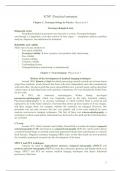ICNP | Practical summary
Chapter 2 | Neuropsychology in Practice à practical 3
Neuropsychological tests
Diagnostic styles
Neuropsychological assessment uses hypothesis testing. Neuropsychologists
run through a a diagnostic cycle that consists of four stages — complaints analysis, problem
analysis, diagnosis, and indication for treatment.
Reliability and validity
Make sure you pay attention to
- Test-retest reliability
- Ecological validity à how accurate a test predicts daily functioning
- Face validity
- Content validity
- Construct validity
- Confounding factors
- Underperformance (intentional or unintentional)
Chapter 4 | Neuroimaging à practical 2
History of the development of medical imaging techniques
Around 1889, Ramón y Cajal described pioneering research carried out on brain tissue
using these methods, which showed that brain cells form independent units that communicate
with each other. He discovered that axons (neurofibrils) have a growth point, and he described
various types of individual brain cells and their connections. He was awarded the Nobel Prize
for his work.
In 1919, the American neurosurgeon Walter Dandy developed
pneumoencephalography, which was frequently used in the early twentieth century.
Pneumoencephalography is an invasive technique in which cerebral fluid is removed and
replaced by air in the brain ventricles. The brain then shows up more clearly on X-ray images,
and these images show, for example, whether the ventricles are enlarged. However, this
procedure was not only invasive but also very painful, and it was soon replaced by more
modern, non-invasive imaging techniques. The first of these was echoencephalography, a
technique in which sound pulses (ultrasound) are delivered to the skull and the reflected pulses
are recorded.
CT-scan
Around 1970, Allan Cormack and Godfrey Hounsfield in London developed computed
axial tomography (CAT), also known as computed tomography (CT). hey can be used to detect
a cerebral haemorrhage or cerebral contusions (punctuate bleeds) after neurotrauma or a basilar
skull fracture. Magnetic resonance imaging (MRI) scans, on the other hand, are now preferred
for scientific anatomical research into the development of the brain.
SPECT and PET techniques
Cameras are used in single-photon emission computed tomography (SPECT) and
positron emission tomography (PET) to locate the radioactive particles and display them as an
image. SPECT and PET are nuclear medical imaging techniques that depict functional
processes in the brain.
1
, MRI-scan
Peter Mansfield and Paul Lauterbur developed magnetic resonance imaging (MRI).
MRI can be used to measure changes in blood flow, which made functional MRI (fMRI)
a fact.
MEG and EROS
Other neuroimaging techniques that are currently used include magneto-
encephalography (MEG), which uses magnetic fields that are produced during neural activity,
event-related optical signal (EROS), which uses infrared light carried by optical fibres to
measure brain activity, and ultrasound, which utilises sound waves and can be used in prenatal
brain research.
Structural imaging
We make a distinction between imaging (the acquisition of data), image processing (the
processing of those data) and applications of the method.
CT-scan
Imaging
In CT research, various images of different ‘slices’ of the brain are usually stored. CT
scans show bone very clearly, and they also clearly distinguish between the ventricles and brain
tissue.
MRI-scan
MRI as a technique
Not only does it provide high-resolution information about brain structure, but it also
clearly distinguishes between grey and white matter. It can show how much of the brain consists
of neuropil (grey matter — which includes the nuclei of the neurons and other cells which make
up the cortex, as well as other deeper nuclei, such as the basal ganglia, thalamus, and
hippocampus).
Structural image processing
The processing and quantification of the brain images are often referred to as image
processing.
Volumetry and VBM
The volume of the brain - that is, the total amount of grey and white matter, the amount
of cerebrospinal fluid, and the number of nuclei in the brain can be determined by means of TI-
weighted MRI scans of the whole brain. This volumetry uses voxels (three-dimensional pixels
with a resolution of approximately 1 mm3). In addition to measuring volumes, it is also possible
to determine the density of the grey and white matter by using voxel-based morphometry
(VBM). VBM can be used to ascertain the density of grey or white matter for each voxel.
DTI
The production of diffusion scans by diffusion tensor imaging (DTI) utilises the
properties of water molecules.
MRS
Magnetic resonance spectroscopy (MRS) is a non-invasive technique that provides
information about the concentrations of certain molecules in the brain.
2





